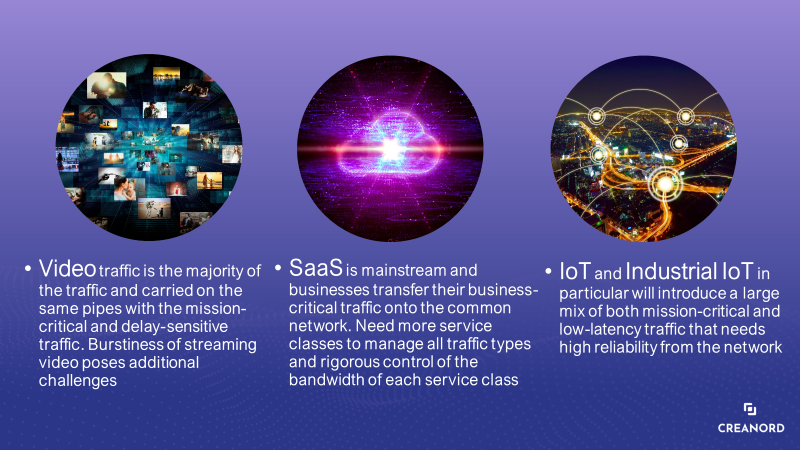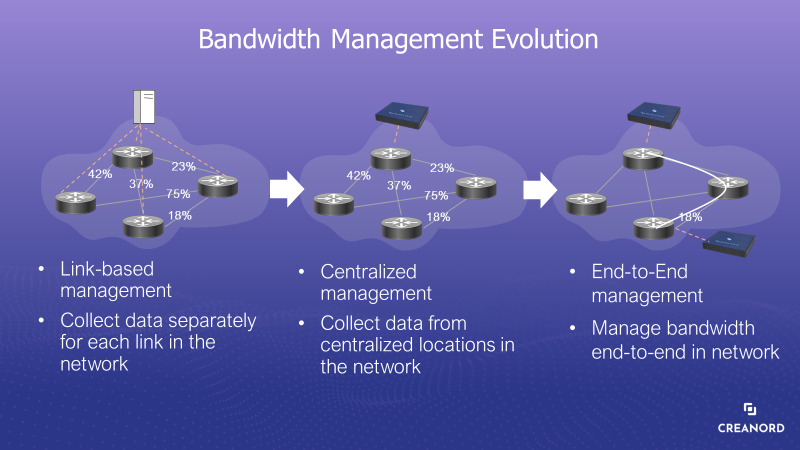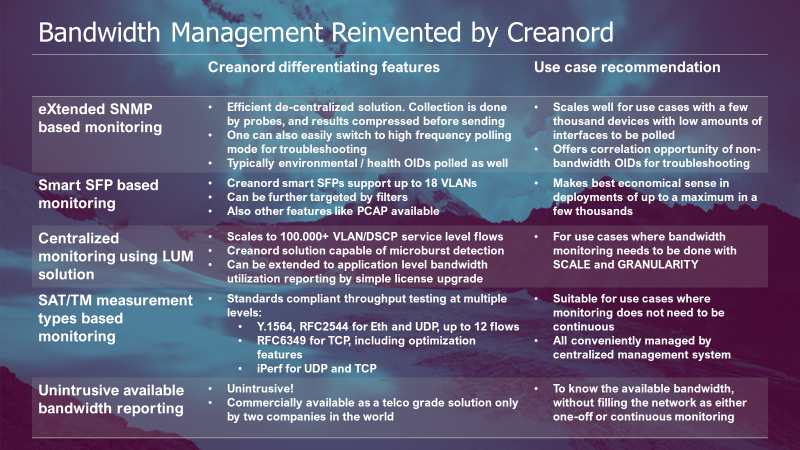Bandwidth Management for the Future

In order to know their networks, service providers have relied on bandwidth management tools since the introduction of packet-based technologies. These tools are important for several reasons. They tell you what types of traffic you have on your network such as video, voice, mission-critical, cloud, gaming etcetera and where this traffic is flowing and they also ensure that each of these traffic types are getting the performance they need from the network in a consistent manner.
With proper bandwidth management tools, you are able to troubleshoot and resolve issues within the network in minutes to keep guaranteed performance levels. They also let you move to a more proactive approach in terms of managing your network as some of these tools may also predict how bandwidth demands are evolving in order for you to proactively add capacity in the network when needed to avoid potential bottlenecks that could affect the end-user experience.
Challenges for Future Networks

Video is already today the majority of the traffic on the Internet and still growing. Streaming video is particularly challenging for networks as it introduces burstiness by the nature of the traffic. Streaming video is fetched in chunks of video segments and fetching a segment is done as quickly as the network can deliver, causing burstiness as the video data is consumed by the player. The video traffic is carried on the same pipes as mission-critical and delay-sensitive traffic meaning that we need to make sure that the bursty video traffic is not degrading the other more critical traffic on the same pipes.
At the same time there is a plethora of mission-critical traffic originating from cloud-based enterprise services, smart factories, smart retail, autonomous vehicles, public safety etcetera. The mission critical traffic has different requirements on the service performance, some of them with very stringent demands on latency, loss, jitter and availability. Therefore, you need to manage a large group of different service classes and you need to have a very granular and exact view of service performance for each of the service classes.
Bandwidth Management Evolution
The evolution of the network and the traffic on the network calls for a totally new approach to how bandwidth is managed. The service providers need to move from a link-based management strategy to a more centralized approach with specialized probes doing detailed and granular analysis of the traffic. Furthermore, as the ultimate goal, the service providers will also need to complement their solutions with end-to-end management capabilities to ensure that bandwidth is available end-to-end for critical services.
The evolution of bandwidth management is illustrated below.

New Ground-breaking Available Bandwidth Measurement Feature
See how it can revolutionize your future network monitoring
Link-Based Monitoring
Traditionally, bandwidth management tools have used a link-based approach, where bandwidth-related counter values are collected using the SNMP protocol from the routers in the network with requests initiated from a central server. The challenges with this approach is that all collection is done from a central location with obvious restrictions on scalability. Delays in the network and the fact that SNMP is a fairly inefficient protocol for data transfer further limits the scalability of the solution. And in case of congested networks, the SNMP requests or responses can get lost as well.
Typically, you can get down to five-minute granularities with this approach for larger networks due to the reasons listed above. You can optimize the solution by distributing probes across the network that collect the bandwidth data. You get better scalability since you are distributing the work and the probes are closer to the routers in the network, which means that delays are smaller. Still, you will probably only get down to one-minute granularities for the collected data, which is not enough to cope with the requirements of the future traffic on the networks.
Another approach to optimize the link-based approach would be to install smart SFPs that can monitor the traffic on the links. The advantage is that the Smart SFP is collecting the traffic statistics locally, removing the delay-issue. The SFP is also offloading the processing work from the router and can compress data to an efficient format before transmitting results to the centralized server. This approach is good for specific links or small networks, but does not scale up to large networks with thousands of sites. Installation of the smart SFPs in a large number of sites just is too expensive when you factor in costs of truck rolls, installation costs and the need for maintenance breaks for each installation as you need to cut the link to install the smart SFP. Hence, this is not a viable solution for large networks.
Centralized Bandwidth Monitoring
To deal with traffic flows from thousands of sites with granularities down to every 10 seconds or even seconds with microburst detection capabilities, a centralized approach is needed. Here you would use specialized probes that can capture a number of 10G or 100G links, extract key packet details for every service class and summarize and concatenate the results and report them back to a centralized location, where the management and reporting solution would offer tools for real-time situational awareness, visibility, troubleshooting, correlation and reporting.
Using specialized solutions optimized for packet processing at high speed is much more efficient both in terms of the performance and cost compared with a link-based approach. You only need to install a few of these central probes to get visibility into your entire network and you are offloading your most expensive devices in the network, the routers, to less expensive devices that are purpose-designed and built for the task.
This approach is well-suited for most types of networks as the networks are typically designed such that the traffic will be transported through a few central locations in the network.
End-to-end Monitoring
Centralized monitoring provides you with visibility into network utilization, micro-burst analysis and trending information, which gets you a long way in managing your network. But there is also a need for an end-to-end view of bandwidth as there are more and more critical traffic types on the network, sometimes with varying demands at non-predictable times. Consider, for instance, a public safety networks where you would use drones for surveillance, virtual reality to help firefighters in low-visibility scenarios, remote doctors to treat patients as they are being transported to the hospital to name a few. In case of a large catastrophe, there will be a huge surge in traffic on the network and people’s lives depend on the traffic getting through the network. Hence, you need to be able to test that the bandwidth is there in advance of the actual need.
Traditional approaches may use service activation and throughput metering test types to find out the available bandwidth. These approaches must be used with care, since they are intrusive tests that may potentially affect the live traffic on the network. Thus, you could only run these tests at times of the day when there are very low amounts of live traffic on the network.
Currently, there are very advanced non-intrusive tools being introduced to the market that can actually do the same job, but without affecting the live traffic. These available bandwidth monitoring tools can measure the available bandwidth by sending out small bursts of packets. Using microsecond-level timestamping mechanisms, the receiving end may then provide an estimate of the available bandwidth by analysing the delays introduced to the packets in the bursts. The bursts are kept small, with suitable time between the bursts for the network to recover, and thus these bursts are not affecting the live traffic. Hence, we may continuously run these tests to ensure that the capacity is there in the network when it is actually needed.
Summary
As networks evolve, more scale and granularity are needed for efficient bandwidth management and for the critical traffic on the networks you need to augment the data with an end-to-end view of the bandwidth as well. Creanord can offer an advanced toolset for efficient bandwidth management, whether you want to optimize your existing link-based solution or move to a more granular and efficient centralized solution complemented by tools for end-to-end bandwidth management. The picture below provides an overview of the Creanord solution.

Creanord is a specialist in service assurance with more than 20 years of experience in developing solutions for network service providers and cloud providers. Creanord’s service assurance solutions enable accurate tracking of network and application quality and performance and the technology has been implemented in over 30 countries and more than 60 networks globally.
Contact us to find out more on how we can help you build outperforming networks.